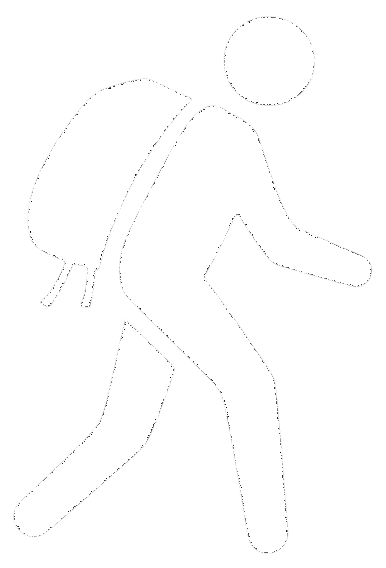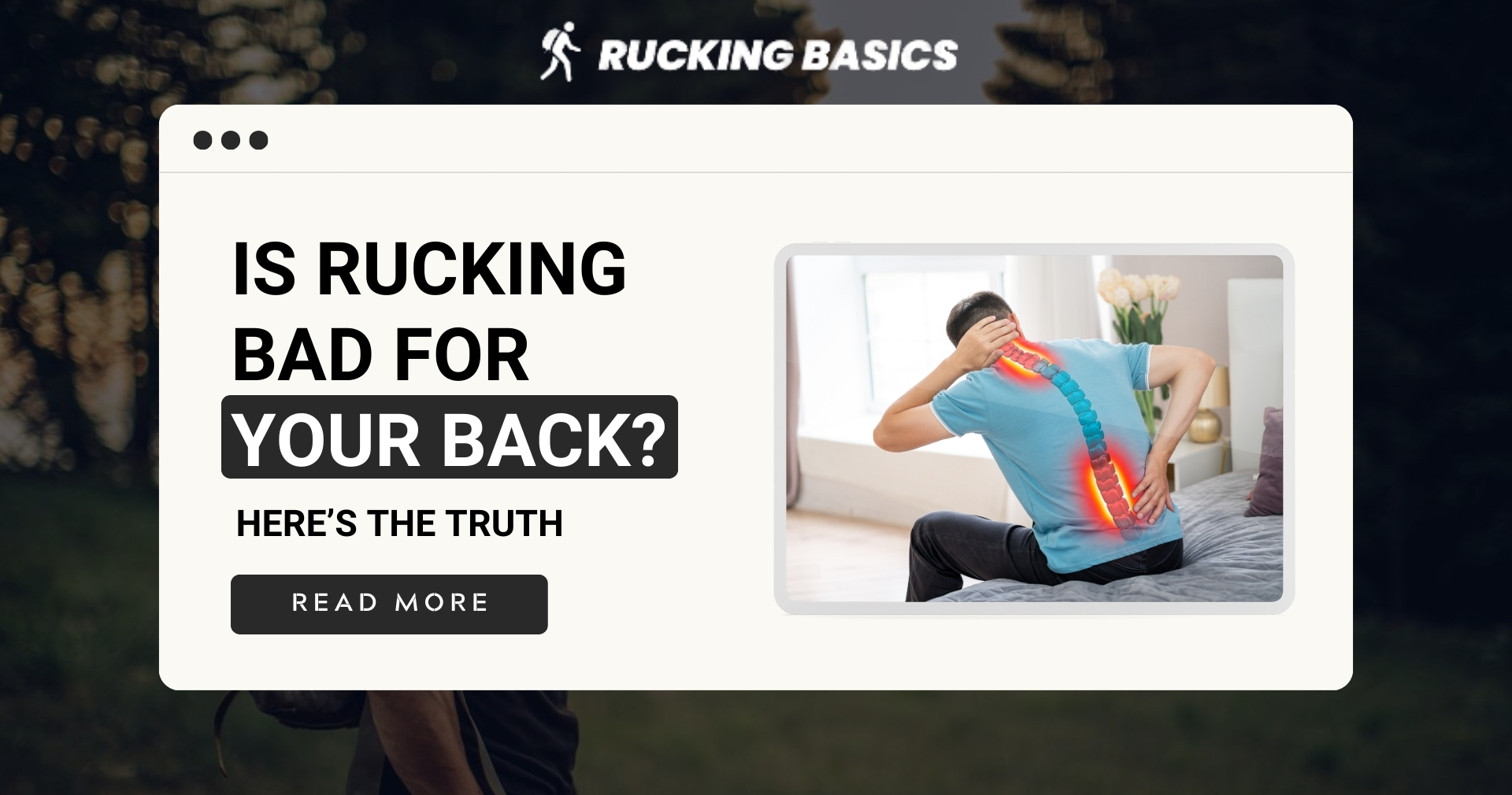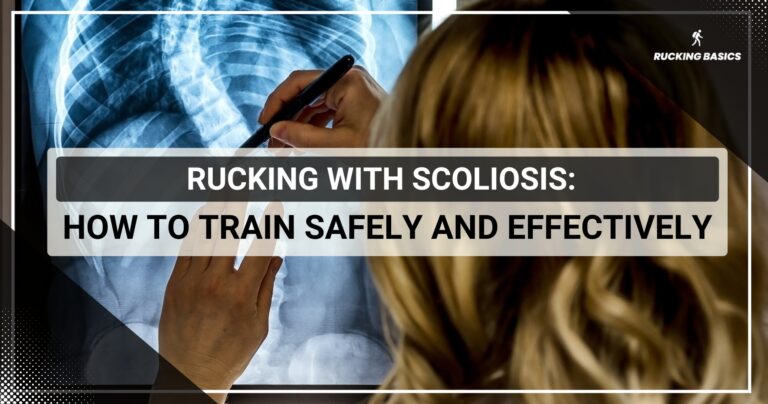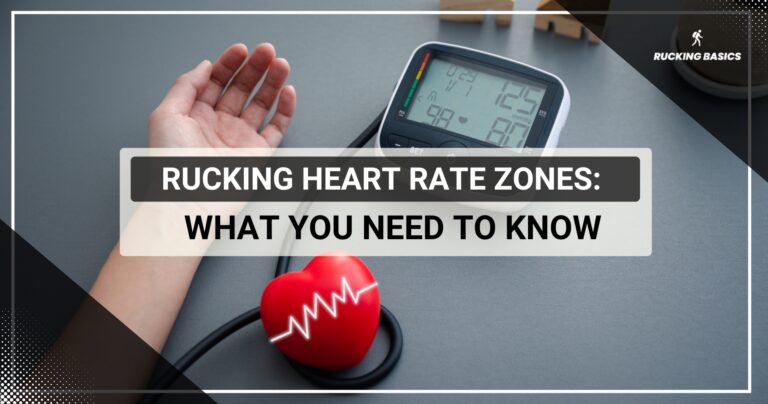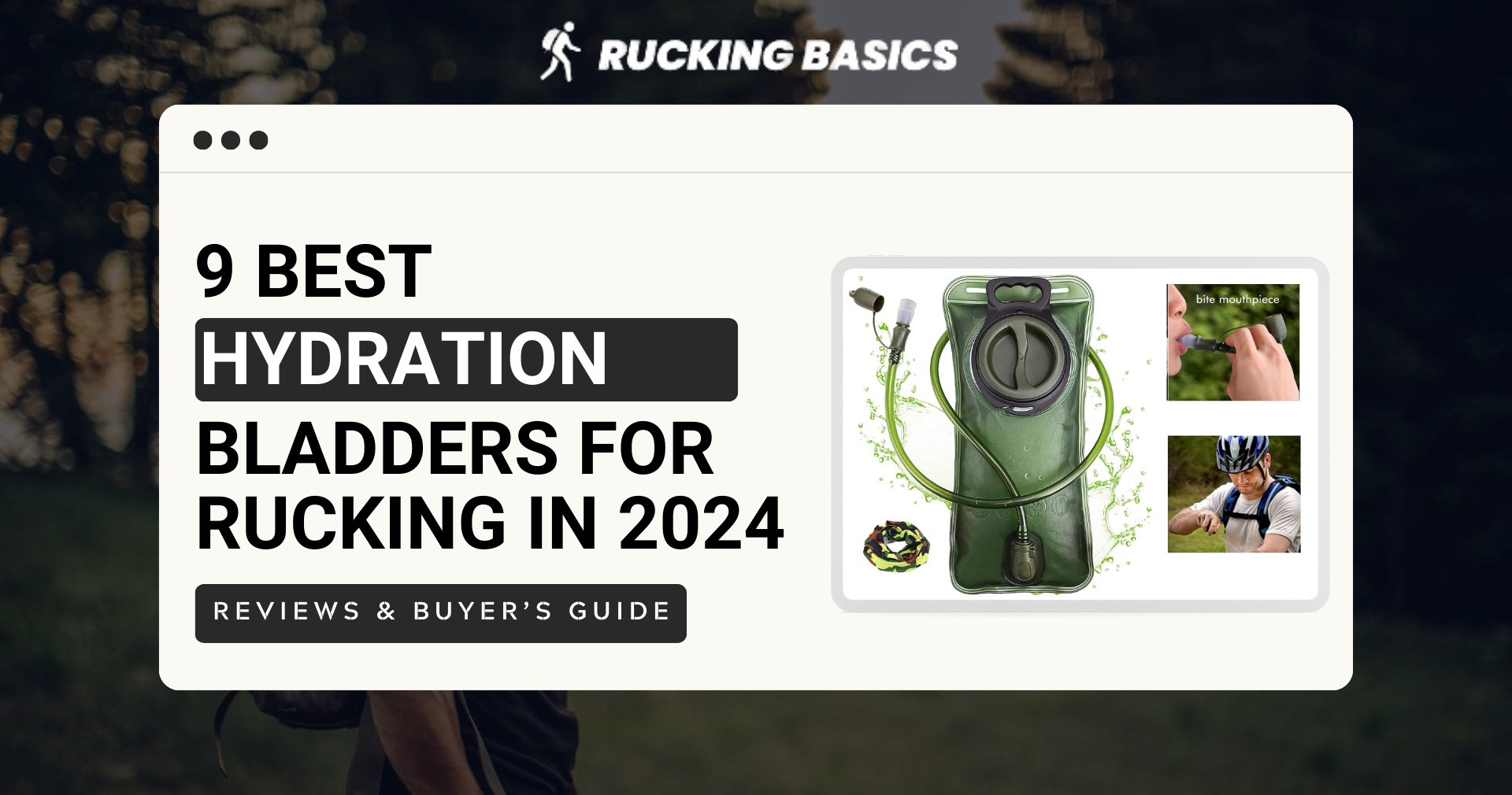Back pain is probably the most prevalent type of pain, and practically everyone experiences it at least sometimes. Low back pain is the first on the list, but other parts of the back can also cause problems. (1)
People are often terrified when this happens, and since rucking involves carrying heavy weights on the back, many are reluctant to try this activity.
I can tell you right away that in over 90% of cases, there is no reason to worry and that rucking can even help. Are you confused now? Don’t worry. Below, I will tell you everything you need to know about the relationship between rucking and back pain.
Is Rucking Bad for Your Back?
Let’s start with the burning question: Does rucking pose a risk to your back health?
No, rucking is not an inherently bad activity for you back. I wouldn’t label any sport as 100% bad for the back, but there is no doubt that weightlifting or golf are much worse than carrying weighted backpack in nature.
Some may wonder, is rucking bad for your knees as well? It’s important to note that while rucking has its challenges, understanding proper techniques and equipment can minimize risks to both your back and knees.
There are factors to consider in order to understand the potential for whether rucking can hurt your back in the form of an injury or cause short-term back pain. The way you distribute weight in your rucksack can either alleviate or exacerbate back strain. Optimal weight distribution is key to minimizing the risk of rucking back pain, and for that, I like to use a hip belt, shoulder straps, and sternum strap.
Maintaining proper posture and form while rucking is also essential for mitigating strain on your back muscles and spine. Paying attention to your body mechanics can make a world of difference. And no, it’s not easy if you’re unfamiliar with biomechanics, but that’s why you can ask someone to film you and get a better idea of how you move.
Frequency and duration of rucking are also important factors. Excessive rucking without adequate rest and recovery can lead to overuse injuries, including back pain.
So, the bottom line is that you should not believe in myths like “Rucking is only for the young and fit” and “Rucking causes irreversible damage to the spine,” but you should be careful.

Signs and Symptoms of Back Issues Related to Rucking
Even an MD will have a hard time determining that the back issue is related to rucking because a back problem usually has multiple causes. However, there are signs that rucking is partly to blame for your stiffness this morning.
First, distinguishing between acute and chronic back pain. Without that, you cannot choose the appropriate course of action. If you have had low back pain for years, and rucking only makes it worse, rucking is not the activity you should stop doing, but to find the underlying cause of LBP.
Start with recognizing warning signs. They will help you take proactive measures to address them before they escalate. Please do not ignore them because your body is telling you something.
Pay attention to any unusual sensations in your back while rucking. I’m not saying that if you feel a symptom all the time, it is not potentially dangerous, but sharp or stabbing pain, dull aches, stiffness, or soreness are red flags.
Notice if you experience any limitations in your ability to move or perform certain movements while rucking as well. Difficulty bending, twisting, or lifting your legs may suggest underlying issues with your back muscles or joints, and your body’s response is stiffness to protect that part.
Numbness, tingling, or “pins and needles” in your back, buttocks, or legs could indicate nerve compression or irritation. That is probably the biggest problem of all that I mentioned since nerves take months or even years to heal.
Mitigating Back Pain and Injury Risk While Rucking
Can you reduce back pain and prevent injuries during your next ruck session? Of course, you can.
Gear and Equipment
Investing in high-quality gear and equipment designed specifically for rucking can significantly reduce the risk of back strain and injury. So, start with proper footwear to reduce pressure on your knee joint, automatically relieving your spine. Then, buy a comfortable and supportive rucksack that excels in weight distribution. You don’t need a rucksack that’s going to hurt you and the same applies to buying a weighted vest suitable for a ruck plate. Socks may not come to your mind as something important, but the comfort and friction socks provide stability during rucking.

Warm-Up and Cooldown
I’m sure you warm up before a gym workout or a basketball match. There is no reason to skip the warm-up before rucking, too. Preparing your body with a thorough warm-up will reduce the likelihood of injury. Post-rucking cooldown is often overlooked, but it is also necessary, especially to prevent muscle stiffness and soreness in your back muscles (and the rest of your body, of course.)
Proper Form and Posture
Focus on alignment, core engagement, and balance to alleviate undue stress on your spine. Thinking about it should not spoil your enjoyment of rucking and the nature around you, but don’t just mindlessly walk forward. A conscious effort to maintain proper form and posture throughout your rucking workout should minimize strain on your back.
Your core muscles play a significant role in maintaining proper posture. If you’re unsure how to activate and strengthen them during your ruck, check out this guide on building rucking abs. A stronger core reduces strain on your back, making rucking more comfortable and enjoyable.
Gradual Progression
Sudden spikes in training are the worst for your body. I can tell you from personal experience — I took a break for a month and then played a long tennis match, and the result was an inflammation of the Achilles tendon that still bothers me. Avoiding sudden spikes in training intensity and gradually increasing the duration and intensity will give your body time to adapt, build muscle and reduce the risk of overuse injuries, including those affecting your back.
Cross-Training
I recommend incorporating cross-training activities and targeted strengthening exercises for the muscles supporting your back. Just as studies support children should not devote themselves to just one activity early on but practice different sports to develop their bodies, the same applies to you. You are not a professional athlete, so there is no reason to do only one activity. Along with ruck, try other physical activities to avoid injuries, kick-start weight loss, and ruck faster.
Managing Rucking Upper Back Pain
While rucking lower back pain often takes center stage, upper back pain is another concern that can arise during rucking. The thoracic spine, shoulder blades, and surrounding muscles are integral to carrying and stabilizing a loaded rucksack. Strain in this area can disrupt your rucking experience, but don’t worry; it’s neither inevitable nor terrible.
Causes of Upper Back Pain During Rucking
These are the main causes of upper back pain while rucking.
Unevenly Packed Rucksack
When the contents of your rucksack are not balanced, with heavier items placed away from your back or distributed unevenly, your upper back muscles have to work harder to stabilize the load. This imbalance forces muscles to overcompensate, leading to strain and discomfort. Over time, this can cause fatigue in the muscles around the shoulder blades and upper spine, contributing to pain.
Unsuitable Weight
We told you this so many times. Carrying an excessively heavy rucksack puts significant stress on your upper back. The muscles in the upper back, including the trapezius, rhomboids, and levator scapulae, are not designed to handle too heavy loads for prolonged periods. When these muscles are overloaded, they will become strained or even injured, resulting in sharp or persistent pain. Go with a reasonable weight.
The GORUCK Padded Stabilizer Hip Belt pulls the bottom of your rucksack inward around your hips or belly and keep it in place, not allowing it to ride upward over your head and shoulders. It will also minimize side-to-side sway and stabilize the load in a position centered on your back.

Poor Posture While Rucking
Slouching or rounding your shoulders while rucking significantly contributes to upper back pain. When you hunch forward, the natural curve of your thoracic spine is exaggerated, placing additional pressure on the vertebrae and the muscles that support them. This poor posture strains the muscles and compresses the discs in the spine.
Inadequate Rucksack Support and Padding
A rucksack that lacks adequate padding in the shoulder straps or support in the back panel can cause pressure points where the straps dig into your shoulders. This constant pressure leads to muscle soreness and irritation in the upper back, especially during long rucks.
Improper Use of Rucksack Straps
How you adjust and use your straps can also affect your upper back. If the shoulder straps are too loose, the rucksack may sway with each step, causing your upper back muscles to work overtime to stabilize it. Conversely, too tight straps can compress the muscles and nerves in your shoulders, leading to pain and numbness.
Lack of Core Strength
Insufficient core strength is a hidden cause of upper back pain during rucking. Your core muscles must stabilize your spine and maintain proper posture. If your core is weak, your upper back muscles may be forced to compensate.
Addressing Upper Back Pain After Rucking
If you experience upper back pain after rucking, even though you have followed all our advice, try to stretch to relieve muscle tension gently. Applying heat or taking a warm bath can also help relax tight muscles. If the pain persists, you need to do upper back strengthening exercises and build endurance and resilience in that area.
Seeking Professional Help
I’m not trying to downplay your pain, nor we from RuckingBasics intend to offer you medical advice.
My years of experience as a personal trainer have shown me that back pain usually goes away on its own. Still, persistent or severe back pain that interferes with your daily activities warrants prompt medical attention.
Various treatment options are available for managing back pain, from physical therapy and chiropractic care to medication and surgical interventions. Work closely with your doctor, and once you are ready, get back to rucking!
Conclusion
Although most of my clients think that it is the end of the world if their back hurts and that it is probably a spinal injury, the reality is quite different. And forget what you heard from Dr Stuart McGill. Similar to knee pain that is not always caused by damage to ligaments or meniscus. In a staggeringly high percentage, we do not know the cause of back pain, meaning it is “non-specific back pain.” So, someone with severe scoliosis can live without any functional problems or symptoms, while at the same time, an individual with an apparently clean MRI suffers daily.
The cause is sometimes related to stress, depression, and similar mental health problems. It can also be due to the fact that pain is an individual thing.
In any case, if you don’t have a diagnosis of severe spine or nerve problems, chances are minimal that rucking will worsen the situation.
Even for individuals with specific conditions like rucking with scoliosis, adjustments such as lighter loads and improved posture can make rucking both safe and enjoyable. These tweaks can prevent unnecessary strain while helping you build back strength over time.
Go find the next GoRuck event and enjoy your next ruck; maybe after that, your back will hurt less, not more.
Frequently Asked Questions
How can I tell if my rucksack is causing my back pain?
You can never be 100% sure that the backpack is the sole cause of back pain. Still, discomfort or pain in your back while rucking can be concerning, and your rucksack might indeed be the culprit. Pay attention to how the weight is distributed and whether it feels balanced on your back. Also, consider the fit of your rucksack and whether it provides adequate support for your spine. If adjusting these factors doesn’t alleviate your back pain, it might be time to reassess your gear or find another reason for back pain.
Are there specific exercises I can do to strengthen my back for rucking?
Yes, many exercises can strengthen your back muscles and thus improve your posture, stability, and resilience while rucking. Incorporate exercises like deadlifts, rows, and planks into your routine to target the muscles that support your spine.
Is it normal to experience soreness in my lower back after rucking?
Lower back after rucking in the form of muscle soreness is not uncommon, especially if you’re new to the activity or have recently increased the intensity or duration of your ruck march. However, I cannot say that it is normal. There’s nothing to worry about if it’s just delayed-onset muscle soreness (DOMS). But if the soreness persists or becomes severe, you must take appropriate measures to address it.
How does rucking compare to other forms of cardio regarding its impact on the back?
Compared to high-impact activities like running, rucking generally places less stress on the back and joints due to the slower pace and controlled movements involved. Knee injury is still possible, but not very common. Yet, rucking is not a 100% low-impact activity because the weight carried during rucking can still exert significant force on the back, particularly if proper form and posture are not maintained.
Is it possible to overdo rucking and cause long-term damage to your back?
Overdoing any sport or physical activity, such as daily workouts in the gym, can be bad for your body in the long term. Pushing yourself too hard or too quickly can increase the risk of overuse injuries, muscle strains, and spinal issues over time. It’s crucial to balance challenging yourself and following your body’s limits, incorporating rest days, proper recovery, and gradual progression.
References
- Wu A, March L, Zheng X, Huang J, Wang X, Zhao J, Blyth FM, Smith E, Buchbinder R, Hoy D. Global low back pain prevalence and years lived with disability from 1990 to 2017: estimates from the Global Burden of Disease Study 2017. Ann Transl Med. 2020 Mar;8(6):299. doi: 10.21037/atm.2020.02.175. PMID: 32355743; PMCID: PMC7186678.
- Balagué F, Mannion AF, Pellisé F, Cedraschi C. Non-specific low back pain. Lancet. 2012 Feb 4;379(9814):482-91. doi: 10.1016/S0140-6736(11)60610-7. Epub 2011 Oct 6. PMID: 21982256.
